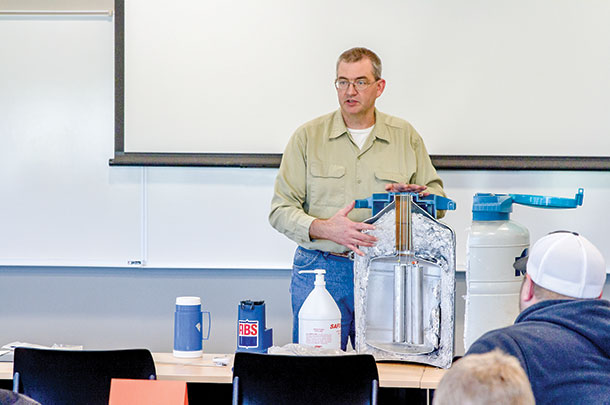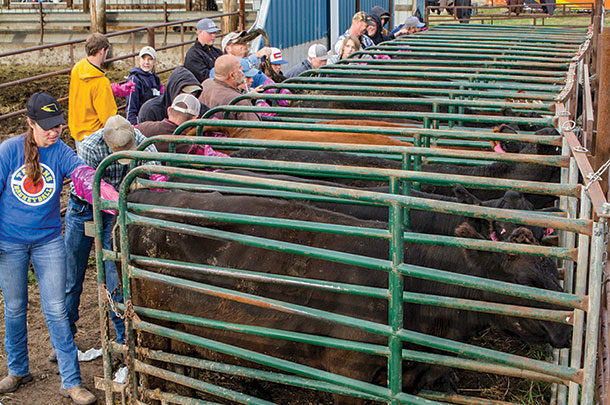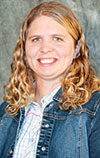However, those who attend an A.I. school bring valuable information about semen handling, A.I. technique and heat detection home to the ranch.
According to Taylor Grussing, a South Dakota State University cow-calf specialist, “Producers come to A.I. school to add high-quality genetics to their commercial cattle herds at a more competitive price tag compared to purchasing a new herd bull each year.”
What can producers expect?
Nineteen ranchers took advantage of SDSU’s A.I. school last fall. First, students met in their classroom space at their regional center and then at Mitchell Livestock. In the classroom, they heard from SDSU Extension beef reproductive management specialist George Perry and Robin Salverson and Taylor Grussing, SDSU Extension cow-calf field specialists.

SDSU is one of many land-grant universities and extension services that offer A.I. schools throughout the year. Select Sires, Cattle Visions, SEK Genetics, Reproduction Enterprises Inc. and AgTech Inc. are among several private companies that also offer A.I. training.
To kick off the first day at the SDSU school, they heard from Perry first about estrus. Then he spoke to the group about some of the steps in storing semen properly and then removing it from the tank.
“We spend so much time in the classroom because we want you ready in the field,” Perry said. “We’re going to teach you the optimum way to do it.”

Perry showed a semen tank cut in half so students could understand where the semen straws sit inside. In addition to the semen tank, which he noted producers did not need to own (they could borrow one from a semen company), producers would also need a tweezer to remove straws from the tank, thermos or straw warmer, straw gun, scissors, sleeves, non-spermicidal lubricant and paper towels.
Perry also spent some time showing the class videos on semen handling, mishandling semen and standing estrus.
Damon Mogck, a fourth-generation purebred Angus operator near Tripp, South Dakota, worked in banking in the Twin Cities up until three years ago when he returned to the farm. Growing up with asthma, his parents pointed him a path away from the farm.

“I decided with today’s medicine I can regulate it, and this is an operation Dad’s built from the ground up and I want to see it continue. It’s a legacy business versus a lot of other businesses you do,” he said.
While his dad, brother and uncle have done A.I. in the past, Mogck wanted to attend A.I. school so he could feel comfortable doing it.
“We’re using registered cows, and conception rates are crucial to the success, and while I could probably just practice and figure my way through it on my own, I just wanted to make sure I had a better comfort level with it,” Mogck said.
Who will benefit?
In the past three years, 25 percent of attendees at SDSU A.I. schools had a herd of fewer than 50 head, 36 percent had more than 200 head and 19 percent for both 50 to 100 and 100 to 200 head. The majority of attendees were commercial cow-calf operators at 67 percent. Seedstock made up 26 percent, club calf at 11 percent, and dairy producers were 7 percent.
Kipp Harlow, a commercial cow-calf producer, traveled all the way to South Dakota from Chillicothe, Ohio, to learn about A.I.’ing cattle. Harlow grew up in Texas on a cattle ranch before joining the Air Force. He moved to Ohio with the VA, which he retired from last January. For the past five years, he has been raising goats.
After going through a number of surgeries, cutting goat hooves was getting to be too much, so he found a cattle guy who wanted goats and they traded. He has about 20 head of cattle and a bull.
While Harlow had A.I.’d goats for a number of years, he wanted to learn how to A.I. cattle because his bull was only getting about half of his cows bred after being with cows for six months. He said his biggest concern with A.I.’ing cows is the difference in size from goats.
“I think it’s more intimidating that it’s a lot larger animal than a goat. Now, you’ve got a 1,200- to 1,400-pound cow that you’re sticking your arm in there,” Harlow said.
Of SDSU’s A.I. school participants in the last three years, 47 percent were younger than 25 years old. Another 47 percent were between 25 to 50 years old. Only 6 percent was older than 50. Twenty-nine percent have been in the cattle business for five to 10 years. Twenty-eight percent were less than five years, and 23 percent were 10 to 20 years. Twenty percent said more than 20 years.
Attendee Whitley Sieverding of Humboldt, South Dakota, is a junior animal science major at SDSU who plans to return to the family farm after graduating. While they hired someone to A.I. some heifers once, they currently use natural service on 150 head.
Sieverding, one of three women at this particular A.I. school, wanted to learn how to A.I. because it looked like fun – and she thought if she learned how, they would not have to hire someone else.
Attending A.I. school helped her relearn the cow anatomy, learn how to use a straw gun and get over her fear of taking semen out of the tank.
“I was scared because they said not to look over the tank. I was scared to touch them with how cold they were. I was scared when I saw the smoke come out,” Sieverding said.
How much is hands-on?
On the evening of the first day of school, students used some of the time to practice removing semen straws from the tank, thawing them and putting on the gun. They also practiced putting the gun into the reproductive tract and finding the cervix on tracts Grussing and Salverson acquired from lockers and packing plants.
Then, early in the morning of the second and third days, students headed to the livestock market and brought up 20 cows to practice on. They locked each cow up into stanchions made from cattle panels, then practiced inserting the gun into the cervix on all of the cows.
For Jake Krohmer, Wessington Springs, South Dakota, who started out showing cattle and then grew the herd to 170 head from commercial to replacement heifers or seedstock and then club calf – while he is on the family farm with his dad, he owns all the cattle and started aggressively growing the herd in 2013.
Krohmer wanted to attend A.I. school so he was not dependent on a couple of other people to do it. His biggest concern was not getting the process down correctly.
Besides practice on actual cows on the second and third days, they also learned more about A.I. synchronization protocols, heat detection, the effects of semen thawing method on fertility, reproductive management and bull selection.
“I’m hoping to get enough knowledge where I can do most of it or all of it by myself and hopefully just get better and better as the years go,” Krohmer said. ![]()
PHOTO 1: Beef producers practice A.I. on cows at Mitchell Livestock.
PHOTO 2: SDSU Extension cow-calf field specialist Robin Salverson explains how to load the straw gun to attendee Whitley Sieverding.
PHOTO 3: SDSU Extension beef reproductive management specialist George Perry explains what happens inside a semen tank.
PHOTO 4: Damon Mogck practices A.I. on cows with advice from SDSU Extension cow-calf field specialist Robin Salverson. Photos by Wendy Sweeter.
Wendy Sweeter is a freelance writer based in South Dakota. Email Wendy Sweeter.











